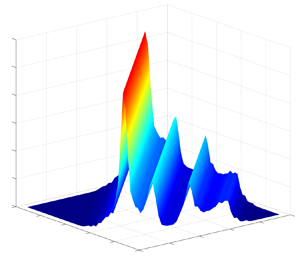Article contents
Gap resonance from linear to quartic wave excitation and the structure of nonlinear transfer functions
Published online by Cambridge University Press: 06 September 2021
Abstract

Resonant response of water waves in a narrow gap, with the interaction of multiple highly resonant modes, is an interesting hydrodynamic phenomenon with practical applications. Gap resonances between two identical fixed rectangular boxes are experimentally investigated for unidirectional waves with broadside incidence. We show that gap resonances can be driven through both linear wave excitation and nonlinear processes, i.e. frequency doubling, tripling and quadrupling – apparently new observations. It is striking that the time histories of the gap resonances excited through different nonlinear interactions are remarkably similar to each other. It seems likely that the nonlinear sum-frequency transfer functions for gap resonances depend strongly on the output frequency sum of the interacting linear components, but only weakly on the frequency difference. In terms of their structure in multiple frequency space (at second order the bi-frequency plane for two components), these transfer functions must then have a near-flat form in the direction(s) perpendicular to the leading diagonal. This is supported by our potential flow calculations of the quadratic transfer functions (QTFs). It is therefore convenient to approximate the QTF matrix as ‘flat’ in the direction perpendicular to the leading diagonal. This approximation is justified through experimental data that includes viscous damping. It is too complex, if not impossible, to calculate the full cubic or quartic transfer functions as direct evidence. However, the experimental analysis does provide some support for the near-flat structure being applicable to transfer functions above second order. The flat form approximation greatly reduces lengthy calculations of the high-order transfer functions.
JFM classification
- Type
- JFM Papers
- Information
- Copyright
- © The Author(s), 2021. Published by Cambridge University Press
References
REFERENCES
- 10
- Cited by





